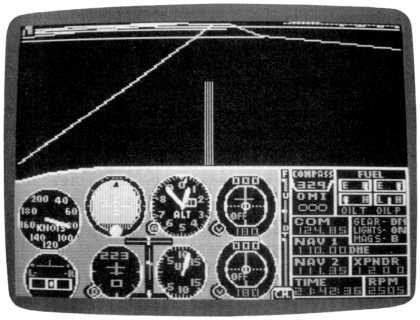40 More Great Flight Simulator Adventures
by Charles Gulick

The
Easement
The Manhattan Project IV
The Manhattan Project IV
| North Position: 17071 | Rudder: 32767 |
| East Position: 20996 | Ailerons: 32767 |
| Altitude: 23 | Flaps: 0 |
| Pitch: 0 | Elevators: 32767 |
| Bank: 0 | Time: 21:30 |
| Heading: 223 | Season: 3-Summer |
| Airspeed: 0 | Wind: 7 Kts, 225 |
| Throttle: 0 |
| This is a slightly different
view of the whole situation, isn't it?
Would I bestow an airport on you that offered only daylight operation?
No way. So the deal I worked out includes a most important easement. |
|
 |
Go into radar and zoom to the
view that shows your aircraft in the
lower half of a rectangle (the left side of which is invisible in the
Piper), and some kind of shape well off to your right. The shape, as
we'll discover, is the Empire State Building. Zoom one more notch up. Now you can see that the rectangle is a strip of pavement, marked off by FDR Drive on the left (again, invisible in the Piper), Fifth Avenue on the right, 42nd Street to the rear, and Edge Road ahead. In the Cessna, you can see where it juts out at Edge Road. So this gives you a hard surface-and a lighted-runway for nighttime operations. It's a beauty-long and wide. But remember that the easement covers nighttime operations only. The hard surface strip is not to be used for daytime landings or takeoffs. If you do that, you'll get me in big trouble. I know I can count on you. |
 |
Let's make a takeoff now
(straight ahead, you're all lined up), and as
soon as you dump your flaps, set up a rear view and press the Pause key. |
 |
This is what your nighttime
landing, in the opposite direction, will
look like just before touchdown. In the Cessna, note how clearly the
strip is lighted. In the Piper, it isn't that clear, and nighttime
operation is a real challenge. Notice how 42nd Street extends about halfway across at the far end, clearly marking the northern extremity of the runway. Still keeping the rear view, unpause, then pause again when you see Edge Road (and simultaneously, in the Cessna, the point where the pavement juts out). This is how it'll look when you're about to cross the threshold on final approach for runway 4. Don't be confused by the apparent shortness of the runway in this perspective. It's an optical illusion. Actually, the "runway" is much longer than you'll ever need. It looks short because the area is very much wider than an ordinary runway. When making an actual landing, you'll stay more to the right than you are now, and the perspective of the far end would terminate in the dark area to the right of the 42nd Street line. In other words, you'll be using only the right half of this paved area for landings (given that you want to execute precisely, as I'm sure you do). Continue looking out the rear as you continue your climb-out, pausing whenever you like to get the feel of the area. Note how the line where the pavement juts out points right to the threshold of runway 4. In both the Piper and Cessna, the point is further defined, and strongly, by Edge Road. Look for Central Park. Then be sure to pause when the Empire State Building appears, and observe that it's bounded by the same crosstown streets as your nighttime strip. When you're sitting ready for takeoff on 22, you'll be able to see the grand old tower directly out the left side. What could be neater? This mode should become your standard mode for night departures and operations from your Manhattan airport, given southerly winds. Next we'll set up a similar mode for takeoffs to the north. |
Table of Contents | Previous Section | Next Section
